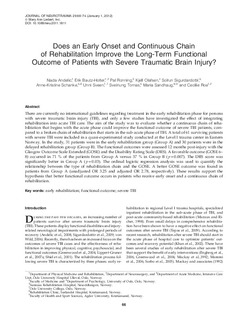| dc.contributor.author | Andelic, Nada | |
| dc.contributor.author | Bautz-Holter, Erik | |
| dc.contributor.author | Ronning, Pal | |
| dc.contributor.author | Olafsen, Kjell | |
| dc.contributor.author | Sigurdardottir, Solrun | |
| dc.contributor.author | Schanke, Anne-Kristine | |
| dc.contributor.author | Sveen, Unni | |
| dc.contributor.author | Tornas, Sveinung | |
| dc.contributor.author | Sandhaug, Maria | |
| dc.contributor.author | Roe, Cecilie | |
| dc.date.accessioned | 2012-05-08T07:22:48Z | |
| dc.date.available | 2012-05-08T07:22:48Z | |
| dc.date.issued | 2012 | |
| dc.identifier.citation | Andelic, N., Bautz-Holter, E., Ronning, P., Olafsen, K., Sigurdardottir, S., Schanke, A.-K., . . . Roe, C. (2012). Does an early onset and continuous chain of rehabilitation improve the long-term functional outcome of patients with severe traumatic brain injury? Journal of Neurotrauma, 29(1), 66-74. doi: 10.1089/neu.2011.1811 | no_NO |
| dc.identifier.issn | 0897-7151 | |
| dc.identifier.uri | http://hdl.handle.net/11250/139015 | |
| dc.description | Published version of an article published in the journal: Journal of Neurotrauma. Also available from the publisher at: http://dx.doi.org/10.1089/neu.2011.1811 | no_NO |
| dc.description.abstract | There are currently no international guidelines regarding treatment in the early rehabilitation phase for persons with severe traumatic brain injury (TBI), and only a few studies have investigated the effect of integrating rehabilitation into acute TBI care. The aim of the study was to evaluate whether a continuous chain of rehabilitation that begins with the acute phase could improve the functional outcome of severe TBI patients, compared to a broken chain of rehabilitation that starts in the sub-acute phase of TBI. A total of 61 surviving patients with severe TBI were included in a quasi-experimental study conducted at the Level I trauma center in Eastern Norway. In the study, 31 patients were in the early rehabilitation group (Group A) and 30 patients were in the delayed rehabilitation group (Group B). The functional outcomes were assessed 12 months post-injury with the Glasgow Outcome Scale Extended (GOSE) and the Disability Rating Scale (DRS). A favorable outcome (GOSE 6-8) occurred in 71 % of the patients from Group A versus 37 % in Group B (p=0.007). The DRS score was significantly better in Group A (p=0.03). The ordinal logistic regression analysis was used to quantify the relationship between the type of rehabilitation chain and the GOSE. A better GOSE outcome was found in patients from Group A (unadjusted OR 3.25 and adjusted OR 2.78, respectively). These results support the hypothesis that better functional outcome occurs in patients who receive early onset and a continuous chain of rehabilitation. | no_NO |
| dc.language.iso | eng | no_NO |
| dc.publisher | Mary Ann Liebert | no_NO |
| dc.subject | early rehabilitation | no_NO |
| dc.subject | functional outcome | no_NO |
| dc.subject | severe TBI | no_NO |
| dc.title | Does an early onset and continuous chain of rehabilitation improve the long-term functional outcome of patients with severe traumatic brain injury? | no_NO |
| dc.type | Journal article | no_NO |
| dc.type | Peer reviewed | no_NO |
| dc.subject.nsi | VDP::Medical disciplines: 700::Health sciences: 800::Health service and health administration research: 806 | no_NO |
| dc.source.pagenumber | 66-74 | no_NO |
| dc.source.volume | 29 | no_NO |
| dc.source.journal | Journal of Neurotrauma | no_NO |
| dc.source.issue | 1 | no_NO |
